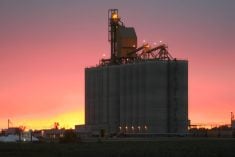A MAN AFTER MY OWN HEART
This issue’s cover story was chosen for a specific reason. If you follow along with this column, you should know by now that I just love on-farm field trials. Maybe the word “trial” makes some of you want to quickly turn away, envisioning flagged plots, endless measuring and counting and time wasted. If that’s you, perhaps then think of these trials more as on-farm evaluations or comparisons.
You may wonder why I harp on this over and over. If you haven’t already done so, go and read this issue’s cover story, then come back here. I’ll wait.
Read Also

Cancer agency reclassifies another herbicide ‘probably carcinogenic’
The WHO’s cancer research agency has now put atrazine, a herbicide well known to corn growers, in the same potential-hazard category where the agency put glyphosate.
OK, we’re good to go?
The beauty of Josh Fankhauser’s story is the simplicity of it, and the willingness of this farmer and his colleagues to not just generate data, but to also analyze it and use it. Again, if the words “analyze” and “data” make your eyes roll, think of it in terms of investigating yield differences — in this case, an extra 10 bushels per acre. That just has to grab your attention.
Fankhauser’s story also proves that while technology does cost money up front, it should (as long as you’re actually keeping of track of changes to your operation) pay for itself over time. What’s more, Fankhauser’s setup proves that you don’t have to own every piece of technology, achieve sub-inch accuracy or have sectional control of your seeder to put technology to work for you. (Of course, if any of you out there are using all of these things and proving their worth with on-farm evaluation, give me a call.)
Which brings me back to my point: when’s the last time you left a test strip or tried a new variety or crop on a small scale? If you have a GPS-equipped yield monitor (and I think you should), what, if anything, do you do with the data it generates?
Technology gets cheaper all the time, and we’re long past the point of precision agriculture being novel. No, not everyone is going to make the leap or use the technology to its fullest, but as Fankhauser’s story illustrates, a relatively small investment of cash and a perhaps larger investment of time to learn to fully use the technology pays off in spades. It’s worth looking at. And now I’ll leave my cheering of on-farm field evaluations on hold for at least one issue of this magazine. I promise.
SEND IN SEED SAMPLES
I’m happy to hear that many of you regularly send in seed lots for germination tests (at a minimum), but too often, it’s left to the last minute. Testing seed early has a few advantages: seed labs are typically a bit slower earlier on, so you may end up with results faster and, should unfavourable results come back, you’ll have the maximum time to source a clean or more vigorous seed lot.
Another advantage of testing seed early applies to marketing. There are factors that downgrade a seed lot for using as seed, but not as a marketable product, such as glyphosate or desiccant damage on peas. If you know well in advance that those bushels you had set aside for seeding should actually be sold, there’s the possibility of capturing some extra cash if the quality is good, especially this year.
Initial findings at labs across the Prairies this winter are alarming. As Lee Hart wrote about in the last issue ofGrainews,many farmers are getting a nasty surprise after sending in seed for testing. Disease levels are extremely high in some cases. Other damage, like frost, sprouting or mildew can also reduce germination or vigour. Not all damage is visible, and the extent of the damage can really only be evaluated with a lab test. The seed lot you use sets up the crop for the entire season — you can’t add seed later or improve the quality, you can only maintain it. Start the year off right by using the highest-quality seed you can afford or get your hands on, keeping in mind that quality seed might be tough to find this year.
Do yourself a favour and get that seed tested now. Oh, and don’t forget — not all diseases can be controlled or suppressed enough by a seed treatment. Talk to your lab tech, your agronomist or consult your provincial disease specialist or provincial agriculture website to determine if the disease found on the seed lot eliminates the possibility of using it for seed. We’ll be tackling this subject further in later issues of Grainews,but it doesn’t hurt to get on this now.
THE FUTURE OF AGRICULTURE
Not only did I spend most of January at farm shows taking in the newest, shiniest gadgets on display, I also had the chance to speak with two classes of students well on their way to a career in agriculture. I spoke at the University of Saskatchewan and at Assiniboine Community College at Brandon, Man. about careers in agriculture media as well as how to write a magazine feature.
At both schools I was pleasantly surprised by the level of interest (they all stayed awake) and by the calibre of questions that they came up with. Who am I kidding? I’m just glad there were questions.
Either way, it was interesting to see how different the curriculum is at the two schools, as well as impressive to see commitment the instructors have to these students and their education. It also makes me think I should have been an awful lot nicer to my instructors.
For those in the industry looking for new talent, I encourage you to take the time to ask students about what was required of them in their course work. ACC and the U of S are just two of the schools I visited, but each college or school in Western Canada has a pretty impressive curriculum. Anyone who has ever had to do a business plan for one of these courses knows that (for the record, I still have nightmares about reconciling statements).
TEXAS IN THE LEXUS
I wasn’t the onlyGrainewsface out and about in January. Longtime readers will recognize the names of Mark Sloane and Andrew Deruyk and may soon readily recognize their faces if their debut speaking engagement is any indication. Mark and Andrew’s discussion on retirement planning at Ag Days in Brandon, Man. packed the room, and several people took the time to introduce themselves and ask questions later. I predict these two are going to be doing a lot of these talks soon.
For those who couldn’t make it to Ag Days, Mark and Andrew have compiled their Texas in the Lexus or Dodge at the Lodge retirement series as part of their Management Minute column for Grainewsstarting with this issue. As their real-life example shows, knowing your financial options early could very well save you hundreds of thousands of dollars, and that’s no exaggeration. In this issue, check page 27 for the beginning of the series.
TAXES AND EXCESS WATER
Not to be outdone, of course, my other columnists have done a standout job this issue. Andy Sirski outlines his favourite tax tips for 2010’s tax year and adds in some thoughts on what you can do this year to help minimize your tax bill (hint: you need to be more organized). Les Henry tackles the issue of high water tables and what this could mean for your farm in 2011, and Tracey Preete, agri-coach with Agri-Trend, offers tips on choosing and applying the correct inoculant. Columns start on page 14 and continue on page 24. Check them out.
Lyndsey [email protected]
———
Wheat &














